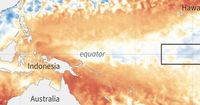The La Niña climate phenomenon has officially concluded, according to the National Oceanic and Atmospheric Administration (NOAA). This announcement marks a significant shift, as the tropical Pacific Ocean has transitioned into a neutral state, devoid of the influences of either La Niña or its counterpart, El Niño. This neutral phase is expected to persist through the boreal spring and summer of 2025, with forecasts suggesting it could last until early autumn.
Signs of La Niña had begun to emerge in the fall of 2024, but it only made a brief appearance, lasting a mere few months. NOAA's Climate Prediction Center confirmed that the Niño 3.4 index, a critical measure for determining the presence of La Niña, recorded a value of -0.01°C in March 2025. This figure is nearly identical to the historical average from 1991 to 2020, confirming the absence of La Niña conditions.
Michelle L’Heureux, a climatologist at NOAA’s Climate Prediction Center, explained that while La Niña's direct effects are no longer present, its atmospheric traces may linger for some time. She noted, “Its atmospheric footprints can persist, although it’s hard to measure how long and with what intensity.”
The implications of this transition are noteworthy, especially regarding hurricane activity. Typically, La Niña contributes to a more active Atlantic hurricane season, while El Niño tends to suppress such activity. With neither phenomenon currently influencing weather patterns, meteorologists face a more unpredictable landscape. This uncertainty is compounded by the fact that ocean temperatures remain abnormally high due to global warming, which could lead to another intense hurricane season, similar to 2023, when 18 named tropical cyclones were recorded, including 11 hurricanes that directly impacted the United States.
As the NOAA report outlines, the forecast for the remainder of 2025 anticipates above-average temperatures across much of the United States during spring and summer, with the exception of the Pacific Northwest and certain northern areas. The combination of elevated temperatures, drought conditions in various regions, and the absence of clear guidance from La Niña or El Niño complicates medium-term weather predictions.
“Global warming continues to intensify, and we are seeing how that turns extreme events into something more frequent,” L’Heureux remarked. She emphasized that this ongoing warming not only affects temperatures but also influences the intensity and duration of droughts and heatwaves.
In Mexico, the end of La Niña signifies a transition into a neutral phase known as ENSO. The Mexican National Water Commission (Conagua) has indicated that while La Niña has concluded, it is expected to return by November 2025. However, NOAA anticipates changes to the ENSO neutral phase by May 8, 2025.
During May, the climate in Mexico is expected to feature the last cold fronts of the season, with 2 to 4 frontal systems anticipated in the first two weeks. The official start of the rainy season is marked on May 15, coinciding with the onset of the cyclone and hurricane season, which is projected to bring approximately 36 tropical cyclones from May to November 2025.
In the absence of La Niña or El Niño, meteorological authorities have warned that the climate in Mexico will be variable. Normal rainfall is expected in the southern, central, and southeastern regions, while the northern areas may experience localized storms due to late cold fronts. The Secretary of the Navy in Mexico has reported that the anticipated average of tropical cyclones during the hurricane season reflects a typical pattern, as the absence of El Niño means storms are not expected to gain additional strength.
However, the unpredictability of weather patterns during neutral phases means that weeks of heavy rainfall may be followed by dry spells, or vice versa. The NOAA's analysis indicates that while the neutral phase of ENSO is less impactful than La Niña or El Niño, it still presents challenges for accurate climate forecasting, especially during the spring, when the phenomenon known as the “spring predictability barrier” often leads to reduced accuracy in seasonal predictions.
As the world transitions away from La Niña, experts continue to monitor ocean conditions closely to anticipate future climate changes. The ongoing interplay between ocean temperatures and atmospheric circulation remains crucial for understanding and predicting global weather patterns.
Looking ahead, the NOAA will provide further updates on the evolution of ENSO in the coming months, particularly as the potential for a new La Niña episode increases later in the year. For now, the focus remains on navigating the complexities of a neutral climate phase and the implications it holds for weather patterns across North America and beyond.







